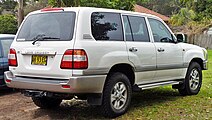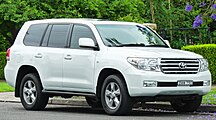Talk:Lexus LX
| This article is rated Start-class on Wikipedia's content assessment scale. It is of interest to the following WikiProjects: | |||||||||||||||||||||
| |||||||||||||||||||||
full-size or not
[edit]| Length | Wheelbase | |
|---|---|---|
| Fourth generation Ford Explorer | 193.4 in | 113.7 in |
| Third generation Mercury Mountaineer | 193.5 in | 113.7 in |
| Saab 9-7X | 193.2 in | 113.0 in |
| Lexus LX | 192.5 in | 112.2 in |
All those are mid-size SUVs. What makes LX full-size? --Mato Rei 16:04, 1 March 2007 (UTC)
Interesting question, I did some digging with data from [1], [2], [3], and [4]. Enigma3542002 20:24, 1 March 2007 (UTC)
I know that the LX is a 1996 design, the oldest of the designs out there, and introduced at a time when competing vehicles were smaller, including older models of the Explorer, etc. Some Asian vehicles also tend to have smaller dimensions for similar vehicle classes than American cars. Yet despite larger wheelbase and length dimensions, the Explorer (and its Mountaineer derivative) and Saab 9-7X seat less passengers, and have less cargo space:
| Std. passenger capacity | Max. passenger capacity | Max. cargo space | |
|---|---|---|---|
| Ford Explorer | 5 | 7 | 83.7 cu. ft. |
| Saab 9-7X | 5 | 5 | 80.1 cu. ft. |
| Lexus GX | 5 | 8 | 77.5 cu. ft. |
| Lexus LX | 8 | 8 | 90.4 cu. ft. |
I believe the classifications also have to do with each companies' lineup, in that the Ford Explorer design has a larger vehicle above it. Thus the Explorer is targeted at a more midsize market, with passenger capacities and cargo volumes to match. Note that the Lexus GX is listed as a midsize SUV and sits below the Lexus LX in the product lineup. With a 188.2 in length and 109.8 wheelbase, the GX is somewhat smaller than the Explorer/Saab models, but has more similar seating arrangements and comparable cargo volume, thus receiving the midsize designation.
In addition to the interior dimensions, the LX is thus viewed as a full-size SUV because in the lineup it is overall larger than the GX and RX, has significantly high towing capacity, and has standard 3 rows of seating. Its capabilities and overall specifications more closely match a full-size SUV's. I found that Car and Driver described the LX size as "a very large vehicle that falls somewhere in bulk between a Range Rover and a Chevy Tahoe," yet "makes good use of its outsized dimensions" [5]. In this 2004 luxury fullsize SUV comparison by Motor Trend, the LX is the 3rd out of 4th in terms of size (Range Rover is smaller). [6]
Also both Edmunds [7] and Forbes Auto [8] call the LX "full-size." So one could say that the LX is a representative, but not the largest, of the full-size category. Hopefully this answers your question! Enigma3542002 20:24, 1 March 2007 (UTC)
- Yes, you made a great answer. Now I see the point of vehicle size class. I always looked it in the exterior way but never the interior way. I was so wrong. It's a nice lesson to me. Thank you very much. --04:00, 2 March 2007 (UTC)Mato Rei
- No problem, glad to be of help. The LX is due for a replacement probably next year as well. 10+ years is a long run... Enigma3542002 04:18, 2 March 2007 (UTC)
Japanese Domestic Market version marketed as Toyota
[edit]There's a necessity to mention a JDM version of LX470, called Toyota Land Cruiser Cygnus. I don't have very detailed information, but it was a RHD version of LX470 sold under Toyota brand in Japan. —The preceding unsigned comment was added by 89.178.133.160 (talk) 21:44, August 20, 2007 (UTC)
This is True , Even in limited amounts there was teh Cygnus in Thailand. SO putting this article seperate of the Land Cruiser is not accurate. The first Lexus LX was not all all in any way different than the Land Cruiser Cygnus . It was offered earlier by a year and was mainly rebadged Lexus for the american market. Otherwise it was a Toyota Land Cruiser Cygnus. The front fascia was not a redesign for the LX but was already a design used on the Cygnus model of the Land Cruiser. The Cygnus offered every plush amenity of the LX and more as in Navigation in 1996 on and power fold step rails on top models. Also it offered 3 wheel options . It was sold until the redesign of the Land Cruiser , but is said to re-enter the product line.Kongkit (talk) 00:02, 17 June 2009 (UTC)KongkitKongkit (talk) 00:02, 17 June 2009 (UTC)
started 1995 or 1996
[edit]We have a small problem for the start date. Production stated in Nov 1995 but sales (at least in the only market with a specified date) started in Jan 1996. Production dates are supposed to cover the start of manufacture. I changed the article to say that the LX was manufacturered by Lexus since 1995. OSX had a valid point that Toyota manufactured it, so changed it to say that Lexus sold it since 1995 - but sales started in Jan 1996. Can anybody think of a way to reword this to cover a production start by Toyota in Nov 1995 and a sales start by Lexus in Jan 1996? Stepho talk 21:54, 19 January 2014 (UTC)
- I've had a go. OSX (talk • contributions) 23:58, 19 January 2014 (UTC)
Merger proposal
[edit]I propose that the following related and similar mergers occur:
My reasoning for this is that the two Lexus models are not unique; they are rebadged Toyotas. In both cases (and for each generation of the two), body panels have been identical in most cases. As shown in the gallery below, the only panels that ever changed for these cars are the bonnet/hood, front fenders, and tailgate. All other panels including doors and rear fenders are shared. This is in contrast to the Lexus ES which has not shared any panels with the Toyota Camry after 1996 (V20 and XV10 models shared panels with the Japan-only hardtops). Lexus GX and LX interiors have been identical to their Toyota donor cars in the early years, but the latest models do not share interiors.
- Lexus GX (J120) v. Toyota Land Cruiser Prado (J120)
-
Identical, except hood and fenders
-
Identical
-
Identical
- Lexus GX (J150) v. Toyota Land Cruiser Prado (J150)
-
Identical, except hood and fenders
-
Identical
-
Unique
- Lexus LX (J80) v. Toyota Land Cruiser (J80)
-
Identical, except grilles
-
Identical
-
Identical
- Lexus LX (J100) v. Toyota Land Cruiser (J100)
-
Identical, except hood
-
Identical, except tailgate
-
Identical (see image)
- Lexus LX (J200) v. Toyota Land Cruiser (J200)
-
Identical, except hood and fenders
-
Identical, except tailgate
-
Unique
Regards, OSX (talk • contributions) 07:54, 13 August 2014 (UTC)
- Support — as nominator. OSX (talk • contributions) 07:54, 13 August 2014 (UTC)
- Oppose — imho merging is unacceptable cause these cars are absolutely different (except their look), GX is more expensive (it costs about 100000$), more splendid and has stronger engine, and Prado should be considered as mid-class SUV (it costs only about 60-70000$), and more of the photos are not identical - signed by 85.140.217.255, 14 August 2014
- You say the "cars are absolutely different (except their look)". To me if they look exactly the same, that would suggest they are exactly the same. All that has been done by Toyota is to develop a single vehicle and extract the largest economies of scale / profit out of the car. When a Toyota is simply "facelifted" to become a Lexus, then that does not really constitute an "absolutely different" model. Also, I fail to see how prices change anything, that is simply Toyota being smart (by charging thousands or 10s of thousands of dollars more for a badge and a nicer interior to an otherwise unchanged model). Engines for the Lexus LX have always been available in the Land Cruiser as well (including the 5.7-litre V8 in the current model); for the Lexus GX, the V8 option has not been available on the equivalent Prado as far as I know. OSX (talk • contributions) 02:21, 14 August 2014 (UTC)
- The LX exceeds wikipedia's criteria for an entirely separate article, just as the Cadillac Escalade article is not presented as a separate trim in Chevrolet Tahoe article, the Lincoln Navigator trim in the Ford Expedition page, the Infiniti QX trim in the Nissan Pathfinder/Nissan Armada/Nissan Patrol articles. While were at it the Buick Enclave should be merged into the GMC Acadia or the Cadillac SRX with Saab 9-4X and so forth, the wikipedia standard for separate article's is already well established, not just with SUVs but cars as well, the Kia Optima is not a trim variant of the Hyundai Sonata. More importantly unlike those vehicles the LX uses an entirely different suspension. Shakinonaplane (talk) 11:32, 14 August 2014 (UTC)
- And how is the suspension different? Even so, it's not enough to keep them separate. The Mercedes-Benz E-Class with air suspension has "different suspension" than the regularly-suspended version as well. Also, the existence of other articles is not bearing on a discussion about this one. OSX (talk • contributions) 13:34, 14 August 2014 (UTC)
- Support - they differ only in details that typically differ between grades - mostly trim. Many other Toyotas have different grades (trim levels) where the hanging body panels get slight tweaks and the interior trim is upgraded. The Lexus versions are really just high grade levels of the Landcruiser - reflecting the different markets they are aimed at. They still share mechanical parts and the basic body. Stepho talk 22:41, 13 August 2014 (UTC)
- Trim levels do not involve different markets, or different panels. "Hanging body panels" not sure exactly what that means, the LX has a different front bumper, front grill, headlamps, hood, front fenders, front and rear doors and tailgate. All that is the same is the rear quarter panel and door glass, not sure about the roof. The interior is not the same at all, none of this supports the arguement for different trim levels. Shakinonaplane (talk) 11:32, 14 August 2014 (UTC)
- As I have said before, the doors are NOT different. They are exactly the same. Have you even bothered to look at the pictures? The contours/lines are identical. Yes, the front fenders, bonnet, and tailgate are different but these are easily changed and often are changed for facelift versions of cars as part of the mid-generation refresh. The interior has changed for the current generations of GX and LX only. OSX (talk • contributions) 07:40, 15 August 2014 (UTC)
- Hanging panels is a common term in the automobile industry that refers to body panels that can be easily removed. This includes doors, bonnets (hoods), tailgates, boots (trunks), guards (wings/fenders), bumpers and possibly grills (although grills may be called trim instead). Toyota loves to give different front body panels (bonnet, guards, bumper) to different markets to make it look unique - very cheap and very effective. The hanging panels can effectively be treated as replaceable trim in the same way that the dashboard and seats can easily be replaced. The basic body (roof, rear quarter panels, floorpan, firewall, chassis rails and the various uprights connecting them) defines the vehicle itself and is common to both the LX and the Landcruiser for any given generation. As for the interior - that is the easiest of all to be replaced. Swap the dash, seats, door trim and floor covering to make it anything from a basic work vehicle (rubber mats, plain dash, vinyl seats) to a full-on luxury vehicle (plush carpet, dash with fancy electronics, heated electrically adjustable seats, etc). Likewise, the suspension is all bolt on stuff that is easily replaced - leaf springs and solid axles for work vehicles, coil springs and IRS for the luxury version. Toyota has had suspension options within the same generation before. And many Toyotas have had multiple engine options for the same vehicle. Stepho talk 05:50, 15 August 2014 (UTC)
- Support. – Cloverleaf II (talk) 08:02, 14 August 2014 (UTC)
- Oppose. - Suspension hardware is different, body is different, interior is totally different, engines are different all that is shared is basic vehicle architecture. Only the Lexus LX (J80) v. Toyota Land Cruiser (J80) were about the same the rest not at all. Shakinonaplane (talk) 09:40, 14 August 2014 (UTC)
- Got a source to backup that suspension hardware is significantly different? I doubt it. Body is not different, engines are mostly the same, and the sharing goes a lot further than "basic vehicle architecture". OSX (talk • contributions) 10:58, 14 August 2014 (UTC)
- The use of poor quality images fails to allow anyone to assess the differences accurately, the LX and Landcruiser do not share the same doors, the doors on the LX are straight vs curved for the Landcruiser, also the rear quarter panels are not the same, again the LX is straight while the Landcruiser is curved, making the doors non-interchangeable, the LX's front doors will not fit into the Landcruiser nor will the rear doors and vice versa. You also neglected to point out the tailgate like the hoods are different. Furthermore with each successive generation and each successive facelift the exterior appearances grow further apart. At the rate the changes take place by the time 4th generation Lexus LX goes on sale the exteriors will be unique in the same way the 3rd generation LX gained a unique interior.
- The images are sufficient for the comparison process. They clearly show that the body panels are by-and-large the same. Your statement is full of inaccuracies. The doors ARE the same, rear-quarter panels ARE the same. I did mention that the tailgates and hoods are unique for the J100 an J200 series. There is no need to spread misinformation to support your argument, because it is easy to see that the doors, and rear-quarter panels are the same. OSX (talk • contributions) 13:27, 14 August 2014 (UTC)
Upper somebody said that Prado and GX are separated from each other like Cadillac Escalade and Chevrolet Tahoe (or Infiniti QX56 and Nissan Patrol). I find this comparison good. There are two different models, if they were same, Toyota wouldn't create two separate models and they wouldn't strongly differ in price. Two different models, at least because were made under different brands and have different prices and complications. — Preceding unsigned comment added by 85.140.220.23 (talk • contribs) 17:02, 14 August 2014
- Again, they are separate marketing models; engineering-wise very little separates the two. As for the separate pricing structures, I fail to see the relevance because Land Cruisers are different prices too, depending on the level of luxury specified). It's the same as how the Fiat Doblò is sold as the Ram ProMaster City is the USA with different front styling and badges, et cetera. Same basic car, different trim to market it differently. Personally, I think the above models should also be merged, but I can only go step-by-step. Wikipedia has a strong history of combining badge engineered models, and very few articles like this exist now (compared to say 5 years ago), but I am working with several other editors to get the last of them merged into their donor vehicle articles. OSX (talk • contributions) 07:40, 15 August 2014 (UTC)
- Oppose Vehicles on the same platform often share components including structural items like floorpans but are still regarded as distinct vehicles. Calling the Lexus models a separate trim is a gross overstatement. — Preceding unsigned comment added by 66.163.84.147 (talk) 13:35, 10 September 2014 (UTC)
- Oppose Understand the logic, but while rebadging may have occured, the overall history of the Land Cruiser and Lexux marques has followed different paths. Merging would muddle matters more than clarify.Denis (talk) 18:29, 6 February 2015 (UTC)
External links modified
[edit]Hello fellow Wikipedians,
I have just modified one external link on Lexus LX. Please take a moment to review my edit. If you have any questions, or need the bot to ignore the links, or the page altogether, please visit this simple FaQ for additional information. I made the following changes:
- Added archive https://archive.is/20031125005115/http://www.carfax.com/DP_Rpt_Links/KBB_Award_Winners.cfm to http://www.carfax.com/DP_Rpt_Links/KBB_Award_Winners.cfm
When you have finished reviewing my changes, you may follow the instructions on the template below to fix any issues with the URLs.
This message was posted before February 2018. After February 2018, "External links modified" talk page sections are no longer generated or monitored by InternetArchiveBot. No special action is required regarding these talk page notices, other than regular verification using the archive tool instructions below. Editors have permission to delete these "External links modified" talk page sections if they want to de-clutter talk pages, but see the RfC before doing mass systematic removals. This message is updated dynamically through the template {{source check}} (last update: 5 June 2024).
- If you have discovered URLs which were erroneously considered dead by the bot, you can report them with this tool.
- If you found an error with any archives or the URLs themselves, you can fix them with this tool.
Cheers.—InternetArchiveBot (Report bug) 00:22, 15 May 2017 (UTC)
A Commons file used on this page or its Wikidata item has been nominated for speedy deletion
[edit]The following Wikimedia Commons file used on this page or its Wikidata item has been nominated for speedy deletion:
You can see the reason for deletion at the file description page linked above. —Community Tech bot (talk) 11:53, 14 October 2021 (UTC)
































